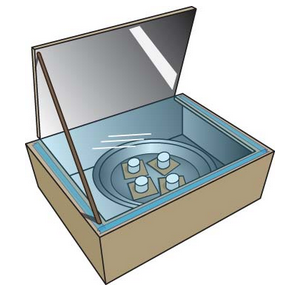The five Earth systems are the geosphere, biosphere, cryosphere, hydrosphere, and atmosphere. Each of these systems plays a crucial role in shaping and sustaining the Earth's ecosystem. Here's a brief explanation of each system:
1. Geosphere: The geosphere refers to the solid parts of the Earth, including the rocks, minerals, and landforms. It encompasses the Earth's crust, mantle, and core. The geosphere is responsible for the formation of mountains, continents, and other geological features. It also influences the distribution of resources and provides a habitat for certain organisms.
1. Geosphere: The geosphere is an essential Earth system that encompasses the solid components of the planet. It includes the Earth's crust, mantle, and core. The geosphere plays a fundamental role in shaping the Earth's surface and influencing geological processes. Here's a more detailed elaboration:
The Earth's Crust: The outermost layer of the geosphere is the Earth's crust. It is composed of various types of rocks, such as igneous, sedimentary, and metamorphic rocks. The crust is not uniformly thick and varies in thickness beneath different regions of the Earth's surface. It is divided into large tectonic plates that float on the semi-fluid asthenosphere beneath them. These plates move and interact with one another, leading to phenomena like earthquakes, volcanic eruptions, and the formation of mountain ranges.
The Mantle: Beneath the Earth's crust lies the mantle, which is the thickest layer of the geosphere. The mantle is composed of solid but flowing rock material. It experiences convection currents that contribute to the movement of tectonic plates on the Earth's surface. The mantle's heat and pressure conditions play a crucial role in the melting and upwelling of magma, leading to volcanic activity.
The Core: At the center of the Earth is the core, which is further divided into the outer core and the inner core. The outer core is composed of liquid iron and nickel, while the inner core is a solid sphere consisting mainly of iron. The core generates the Earth's magnetic field through a process called the dynamo effect. This magnetic field plays a vital role in protecting the Earth from harmful solar radiation and influencing the behavior of compass needles.
Formation of Mountains and Continents: The geosphere is responsible for the formation of majestic mountain ranges, such as the Himalayas, Andes, and Rockies. These mountains are the result of tectonic plate collisions, where the crust is pushed upward, folded, and faulted due to the immense forces generated by the movement of the Earth's plates. Similarly, the geosphere is involved in the formation of continents through processes like continental drift, where land masses move and collide over millions of years.
Distribution of Resources: The geosphere plays a significant role in the distribution of Earth's resources. Minerals, such as gold, copper, iron, and coal, are found within the Earth's crust and are extracted for various purposes. The geosphere also contains valuable energy resources, including fossil fuels like oil, natural gas, and coal. Understanding the geosphere's composition and geological processes is crucial for identifying and exploiting these resources sustainably.
Habitat for Organisms: The geosphere provides habitats for various organisms. It includes diverse ecosystems such as deserts, forests, grasslands, and mountains. Different organisms have adapted to thrive in specific geological environments, taking advantage of the available resources and conditions. For example, certain plants are well-suited to grow in rocky terrains, while burrowing animals find shelter in underground formations. The geosphere's features and composition influence the distribution and characteristics of these habitats.
In summary, the geosphere encompasses the solid components of the Earth, including the crust, mantle, and core. It is responsible for the formation of mountains, continents, and other geological features. The geosphere influences the distribution of Earth's resources and provides habitats for various organisms. Understanding the geosphere is crucial for studying Earth's history, geological processes, and the interplay between the planet's physical features and its living organisms.
2. Biosphere: The biosphere comprises all living organisms on Earth, including plants, animals, and microorganisms. It encompasses various ecosystems such as forests, oceans, deserts, and grasslands. The biosphere interacts with the other Earth systems to create a delicate balance of energy and matter exchange. Organisms depend on the biosphere for food, shelter, and other resources.
Biosphere: The biosphere is a vital Earth system that encompasses all living organisms and their interactions with the environment. It extends from the deepest oceans to the highest mountains and from the most remote forests to the bustling cities. Here's a more detailed expansion on the concept:
Ecosystems and Biodiversity: The biosphere consists of diverse ecosystems that support a wide array of plant, animal, and microbial life. These ecosystems can range from lush rainforests to expansive coral reefs, from vast grasslands to icy tundra. Each ecosystem has its unique set of organisms adapted to its specific environmental conditions. The biosphere's immense biodiversity plays a crucial role in maintaining the stability and resilience of the Earth's ecosystems.
Interactions with the Physical Environment: The biosphere interacts closely with other Earth systems. For instance, plants in the biosphere undergo photosynthesis, using sunlight, water, and carbon dioxide to produce oxygen and store energy in the form of carbohydrates. This process contributes to the cycling of carbon and oxygen in the atmosphere and the regulation of the planet's climate. Additionally, the biosphere interacts with the hydrosphere through processes like evaporation, precipitation, and the water cycle, influencing the distribution of water resources.
Energy and Matter Exchange: Within the biosphere, energy and matter flow among living organisms and their environment. Producers, such as plants and algae, capture solar energy and convert it into chemical energy through photosynthesis. This energy is then transferred through the food chain as organisms consume and are consumed by others. Nutrients and organic matter are recycled as decomposers break down dead organisms and waste, replenishing the soil and providing essential elements for new growth.
Dependency on the Biosphere: All organisms, including humans, depend on the biosphere for their survival and well-being. The biosphere provides essential resources such as food, water, shelter, and medicine. It also offers various ecosystem services, including climate regulation, water purification, soil fertility, and pollination. Human activities can impact the biosphere through habitat destruction, pollution, and the introduction of invasive species. Understanding the intricate web of life within the biosphere is crucial for conserving biodiversity and maintaining the planet's ecological balance.
Adaptation and Evolution: Organisms in the biosphere continuously adapt to their surroundings through the process of natural selection. They evolve traits that enhance their chances of survival and reproduction in specific environments. Over time, this leads to the diversification of species and the formation of complex ecological relationships. The biosphere's evolutionary processes have shaped the Earth's biodiversity and continue to unfold, providing opportunities for scientific inquiry and discovery.
Conservation and Sustainability: Recognizing the value and fragility of the biosphere, efforts are made to conserve and sustainably manage its resources. Conservation practices aim to protect endangered species, preserve ecosystems, and maintain ecological integrity. Sustainable practices involve balancing human needs with the long-term health of the biosphere, ensuring that future generations can continue to benefit from its services. Education and awareness play a vital role in promoting responsible stewardship of the biosphere and fostering a sense of environmental responsibility.
In summary, the biosphere encompasses all living organisms and their interactions with the environment. It includes diverse ecosystems and is essential for supporting life on Earth. The biosphere influences and is influenced by other Earth systems, and it plays a crucial role in energy and matter exchange. Humans and other organisms rely on the biosphere for resources and services, highlighting the need for conservation and sustainable practices. Understanding the complexity and interconnectedness of the biosphere is fundamental to studying life on Earth and promoting its long-term well-being.
3. Cryosphere: The cryosphere consists of all the frozen water on Earth, including glaciers, ice caps, snow, and permafrost. It plays a crucial role in regulating global climate by reflecting sunlight back into space and affecting ocean currents. The cryosphere also provides habitats for specialized organisms and influences water availability in different regions.
Cryosphere: The cryosphere refers to the portion of the Earth's system that is composed of frozen water. It encompasses a variety of forms, including glaciers, ice caps, icebergs, sea ice, snow cover, and permafrost. Here's a more detailed expansion on the concept:
Regulation of Global Climate: The cryosphere plays a significant role in the regulation of global climate. Ice and snow have high albedo, meaning they reflect a significant amount of sunlight back into space. This reflective property helps to cool the Earth's surface by reducing the amount of solar radiation absorbed. By reflecting sunlight, the cryosphere helps to regulate temperature patterns, particularly in polar regions. Changes in the cryosphere, such as melting glaciers and reduced snow cover, can affect the overall energy balance of the Earth's climate system.
Water Storage and Distribution: The cryosphere is a crucial reservoir of freshwater, storing vast amounts of water in the form of ice. During periods of melting, such as in warmer seasons or in response to climate change, this stored water is released, contributing to the water supply of rivers, lakes, and groundwater systems. The gradual melting of glaciers and ice caps over time also contributes to sea-level rise, which has implications for coastal communities and ecosystems worldwide.
Habitat for Specialized Organisms: Despite the extreme conditions, the cryosphere supports a surprising variety of life forms. From microorganisms that live within ice to large mammals that thrive in polar regions, numerous species have adapted to survive in these icy environments. Examples include polar bears, penguins, seals, and a range of cold-adapted fish and invertebrates. The cryosphere provides unique habitats and ecological niches for these specialized organisms, contributing to the overall biodiversity of the planet.
Influence on Ocean Circulation: Melting ice from the cryosphere has a significant impact on ocean currents and circulation patterns. As freshwater from melting glaciers and ice caps enters the ocean, it can affect the density and salinity of seawater, potentially disrupting oceanic currents. Changes in ocean circulation patterns can have far-reaching consequences for climate systems and the distribution of heat around the globe.
Indication of Climate Change: The cryosphere is highly sensitive to changes in temperature and is considered a key indicator of climate change. The shrinking of glaciers, thinning of sea ice, and reduction of snow cover in certain regions are all observed impacts of global warming. Monitoring the cryosphere provides scientists with valuable data to understand the effects of climate change and make predictions about future environmental changes.
Water Resource Management: The cryosphere has a direct impact on water availability in different regions. Melting snow and ice contribute to freshwater supplies, which are essential for human populations, agriculture, and ecosystems. Understanding the dynamics of the cryosphere is crucial for effective water resource management, particularly in areas where the cryosphere acts as a natural reservoir or regulates the timing and quantity of water flow.
Research and Exploration: The cryosphere continues to be an area of active research and exploration. Scientists study ice cores to understand past climate conditions, examine the dynamics of glaciers to predict their behavior, and investigate the impact of changing snow cover on ecosystems. Exploration of the polar regions, where the cryosphere is most extensive, provides valuable insights into Earth's history, climate patterns, and the potential for discovering new species and adaptations.
Mitigation and Adaptation Strategies: The changing cryosphere poses challenges and opportunities for mitigation and adaptation strategies. Efforts are underway to mitigate climate change by reducing greenhouse gas emissions and slowing the loss of ice and snow. Adaptation strategies focus on understanding and preparing for the impacts of cryospheric changes, such as developing coastal defenses against rising sea levels or implementing measures to conserve water resources in regions heavily reliant on glacial meltwater.
In summary, the cryosphere represents the frozen water component of the Earth's system and encompasses glaciers, ice caps, snow, and permafrost. It plays a crucial role in global climate regulation, water storage and distribution, and provides unique habitats for specialized organisms. Changes in the cryosphere are closely linked to climate change and have implications for ocean circulation, water resources, and ecological systems. Studying and understanding the cryosphere is vital for assessing the impacts of climate change, developing sustainable water management strategies, and preserving fragile ecosystems.
4. Hydrosphere: The hydrosphere refers to all the water on Earth, including oceans, rivers, lakes, groundwater, and atmospheric water vapor. It plays a vital role in the Earth's climate system, acting as a medium for heat transfer and regulating temperature. The hydrosphere supports diverse aquatic ecosystems and provides water for drinking, agriculture, and other human activities.
Hydrosphere: The hydrosphere encompasses all the water on Earth, including oceans, seas, lakes, rivers, groundwater, and even water vapor in the atmosphere. It is an essential component of the Earth's system and plays a crucial role in various aspects of our planet. Here's an expansion and elaboration on the concept:
Climate Regulation: The hydrosphere plays a significant role in the regulation of Earth's climate. Water acts as a medium for heat transfer, absorbing and releasing large amounts of heat energy. The movement of water through various processes, such as evaporation, condensation, and precipitation, helps distribute heat around the globe, influencing weather patterns and the overall climate system. The hydrosphere, particularly the vast oceans, acts as a heat sink, absorbing and storing heat from the sun and releasing it slowly over time.
Aquatic Ecosystems: The hydrosphere supports a wide range of aquatic ecosystems, including marine, freshwater, and brackish environments. These ecosystems are home to diverse plant and animal species, providing habitats for marine life such as coral reefs, kelp forests, wetlands, and estuaries. The hydrosphere supports a complex web of interactions among organisms, including food chains, nutrient cycling, and various ecological processes that contribute to the overall health and functioning of these ecosystems.
Water Supply: The hydrosphere is the primary source of freshwater, which is essential for various human activities, including drinking, agriculture, industry, and sanitation. Rivers, lakes, and groundwater reservoirs serve as freshwater sources for communities around the world. However, it is important to note that only a small fraction of Earth's water is freshwater, and the availability of clean, potable water is a pressing global issue. Sustainable water management practices and conservation efforts are crucial for ensuring a reliable and equitable water supply.
Weather and Precipitation: The hydrosphere plays a critical role in the formation of weather patterns and the occurrence of precipitation. Through the processes of evaporation, condensation, and transpiration, water vapor is released into the atmosphere, forming clouds and ultimately leading to rainfall, snowfall, or other forms of precipitation. The distribution and amount of precipitation in different regions have profound effects on local climates, ecosystems, and human activities such as agriculture and water resource planning.
Hydrological Cycle: The hydrosphere is part of the Earth's hydrological cycle, which is a continuous process of water movement and exchange between the atmosphere, land, and oceans. This cycle involves processes such as evaporation, condensation, precipitation, runoff, infiltration, and groundwater flow. The hydrological cycle is essential for the natural distribution and recycling of water, ensuring its availability for various ecosystems and human needs.
Water as a Solvent: Water's unique properties as a solvent are crucial for many chemical and biological processes. It allows for the dissolution of minerals, nutrients, and gases, facilitating their transport and availability for organisms. The hydrosphere acts as a medium for nutrient cycling and the transport of essential elements, playing a vital role in supporting life and ecological processes.
Erosion and Landforms: The hydrosphere is a powerful agent of erosion, shaping the Earth's landforms over millions of years. Moving water, in the form of rivers, streams, and waves, erodes rocks and sediments, carrying them to different locations and depositing them to form new landforms. Examples of water-driven landforms include canyons, valleys, deltas, and coastal features such as cliffs and beaches. The erosive power of water contributes to the continuous reshaping of the Earth's surface.
Oceanic Circulation: The hydrosphere, particularly the oceans, plays a crucial role in global oceanic circulation. Ocean currents, driven by various factors such as temperature, salinity, and wind patterns, distribute heat around the planet and influence climate. These currents also transport nutrients, marine organisms, and pollutants, impacting marine ecosystems on a global scale.
Understanding the hydrosphere and its interactions with other Earth systems is vital for addressing water-related challenges, managing water resources sustainably, and mitigating the impacts of climate change. It highlights the intricate connections between water, climate, ecosystems, and human well-being, emphasizing the importance of responsible stewardship and conservation efforts.
5. Atmosphere: The atmosphere is the layer of gases surrounding the Earth. It consists of various gases, such as nitrogen, oxygen, carbon dioxide, and trace amounts of other gases. The atmosphere protects the Earth from harmful solar radiation, regulates temperature, and helps distribute heat and moisture around the globe. It also plays a crucial role in weather patterns and climate.
Atmosphere: The atmosphere is a vital component of Earth's system, encompassing the layer of gases that surrounds the planet. It serves multiple essential functions that are crucial for sustaining life and shaping the Earth's climate. Here's an expansion and elaboration on the concept:
Protective Shield: One of the primary roles of the atmosphere is to act as a protective shield for the Earth's surface. It absorbs and filters a significant portion of the Sun's harmful ultraviolet (UV) radiation, preventing it from reaching the surface and safeguarding living organisms from its damaging effects. The presence of the ozone layer in the stratosphere plays a crucial role in shielding the biosphere from harmful UV radiation.
Temperature Regulation: The atmosphere helps regulate the Earth's temperature through various mechanisms. It allows for the absorption and retention of solar energy, contributing to the greenhouse effect. Certain gases, such as carbon dioxide and methane, trap heat in the lower atmosphere, preventing it from escaping into space. This greenhouse effect maintains a relatively stable average temperature on Earth, making it suitable for supporting life.
Heat Distribution: The atmosphere plays a critical role in redistributing heat around the planet. Through processes such as convection, conduction, and advection, heat energy is transferred from regions of surplus to those of deficit. Warm air rises in the atmosphere, creating areas of low pressure, while cooler air sinks, leading to areas of high pressure. These pressure differences drive atmospheric circulation, including the formation of winds and weather patterns, which help distribute heat globally.
Weather and Climate: The atmosphere is intimately linked to weather and climate. Weather refers to the short-term variations in atmospheric conditions, such as temperature, humidity, wind speed, and precipitation, occurring over hours to days. Climate, on the other hand, refers to long-term patterns and averages of weather conditions over a specific region or the entire planet. The composition and dynamics of the atmosphere, including air pressure, temperature gradients, and moisture content, influence the development of weather systems and the occurrence of climate patterns.
Air Quality: The quality of the air we breathe is directly influenced by the composition of the atmosphere. Human activities, such as industrial processes, transportation, and agriculture, can release pollutants into the air, affecting air quality and human health. The atmosphere acts as a medium for the dispersion and transport of pollutants, impacting local, regional, and even global air quality. Monitoring and understanding atmospheric composition and pollutants are crucial for mitigating air pollution and its impacts.
Hydrological Cycle: The atmosphere plays a crucial role in the Earth's hydrological cycle, which involves the continuous movement and exchange of water between the surface, atmosphere, and hydrosphere. Through processes such as evaporation, condensation, and precipitation, water is cycled through the atmosphere, distributing it across different regions of the planet. The atmosphere acts as a conduit for the transport of water vapor, facilitating the occurrence of rainfall, snowfall, and other forms of precipitation.
Wind Patterns: The atmosphere's circulation patterns give rise to winds, which play a significant role in shaping weather patterns, ocean currents, and the distribution of heat and moisture. Global-scale wind systems, such as the trade winds and the jet stream, are driven by temperature gradients and the Earth's rotation. These wind systems influence weather patterns, air pollution dispersion, and the navigation of ships and aircraft.
Space Exploration: The atmosphere is also of critical importance for space exploration. It acts as a protective barrier against micrometeoroids and space debris, burning them up as they enter the Earth's atmosphere. The study of the atmosphere's composition, dynamics, and behavior is essential for understanding the conditions for space travel, re-entry of spacecraft, and the potential habitability of other celestial bodies.
Understanding the atmosphere's composition, dynamics, and interactions with the other Earth systems is crucial for predicting weather patterns, studying climate change, and developing strategies for mitigating the impacts of human activities. It highlights the intricate web of connections between the atmosphere, biosphere, geosphere, cryosphere, and hydrosphere, emphasizing the need for interdisciplinary approaches to address global environmental challenges.
These five Earth systems are interconnected and constantly interact with one another, creating a dynamic and complex system that sustains life on our planet. Understanding these systems and their interactions is essential for studying and addressing environmental issues and promoting the well-being of our planet and its inhabitants.
What is the Biosphere?
The Biosphere: A Closed System
PROBLEM-SOLVING ACTIVITY: HOW DO EARTH’S SPHERES INTERACT?
Biosphere Encyclopedia of Earth
Cross-Curricular Activities Connected to Earth Science, Grade 5 Earth and Space Systems
What Is The Earth's Atmosphere?
TEACHER BACKGROUND: EARTH’S ATMOSPHERE
Lesson One (Teacher)“Introduction to the Atmosphere”
The Ozone HoleWe Need More Sunscreen
UAMN Virtual Family Day: Amazing EarthAtmosphere Collage
Identify the layers of Earth’s atmosphere
What is the Earth's Geosphere?
The Earth System The Geosphere
Directed Reading PacketGeosphere Unit
The 4 Spheres of the EarthLearn about the Atmosphere, Biosphere, Hydrosphere and Lithosphere
What Is The Earth's Hydrosphere?
Earth systems. Atmosphere Biosphere. Earth Systems. Hydrosphere Geosphere and. Cryosphere.What Is the Earth's Cryosphere?
How do Earth Systems Interact?
Geosphere-biosphere-hydrosphere interactions in the Earth
Climate Kids Activities | |
 | Make Sun s'mores! You won't need a campfire for these. Download PDF |
 | Make a terrarium mini-garden! Put the greenhouse effect to work. Download PDF |
 | Make your own bird feeder! Want to take a close-up look at the birds in your neighborhood? Follow these simple instructions to make a bird feeder that birds won’t be able to resist! Download PDF |
 | Make a garden lampshade! In this activity, you can make a garden on a lampshade. When you turn the light on, you can see what’s in the soil. Download PDF |
 | Make an ocean ecosystem dessert! In this activity, learn to make a cool and tasty version of the ocean ecosystem at home! Download PDF |
 | NASA Climate Kids Valentines! Print these NASA Climate Kids Valentine's Day cards and give them to family and friends! Download PDF |
 | Make a NASA Climate Kids Pumpkin! Celebrate the fall season and Halloween by making your very own NASA Climate Kids pumpkins with these easy-to-use stencils! |
Climate Kids Posters and Guides | |
 | A Guide to Climate Change for Kids! NASA scientists have been studying Earth’s climate for more than 40 years. We used what we’ve learned in that time to answer some of your biggest questions! Download PDF |
 | Meet the Greenhouse Gases! These trading cards will teach you what these gases are all about! |
 | What's the difference between weather and climate? Check out this poster to find out and to learn about how NASA satellites are keeping an eye on conditions on Earth! Download PDF |
